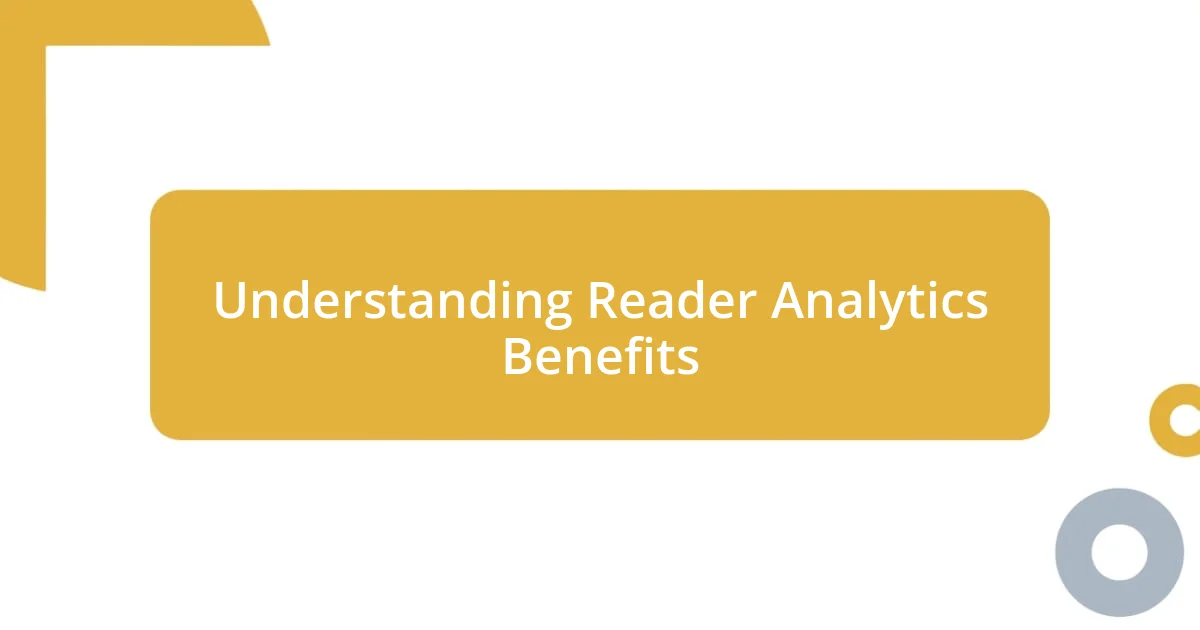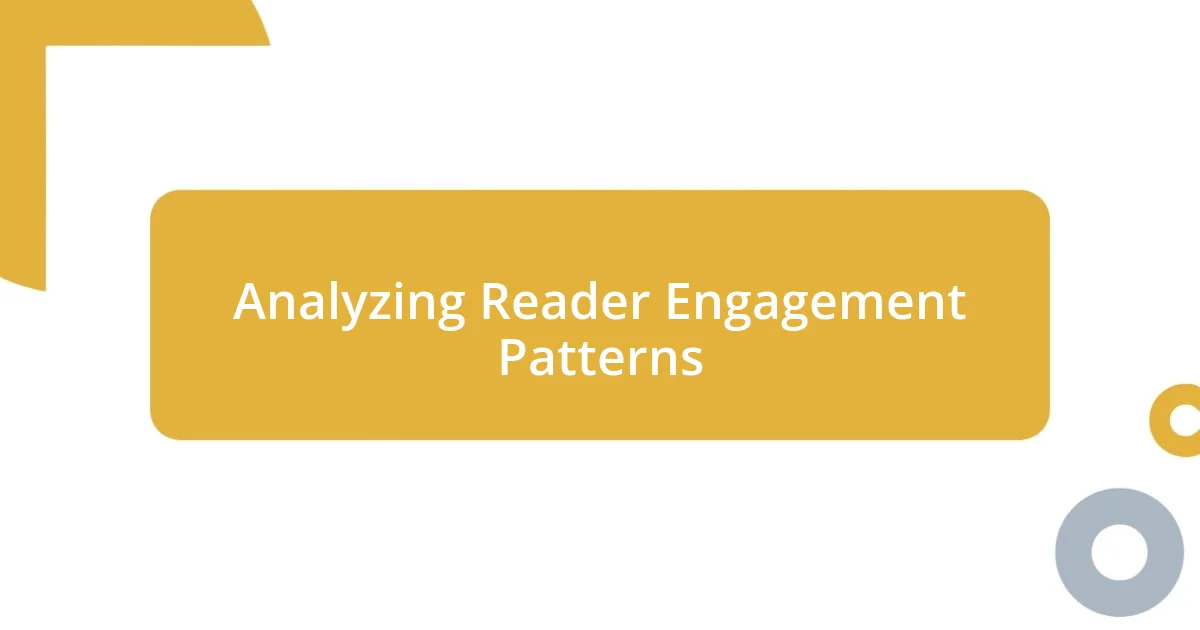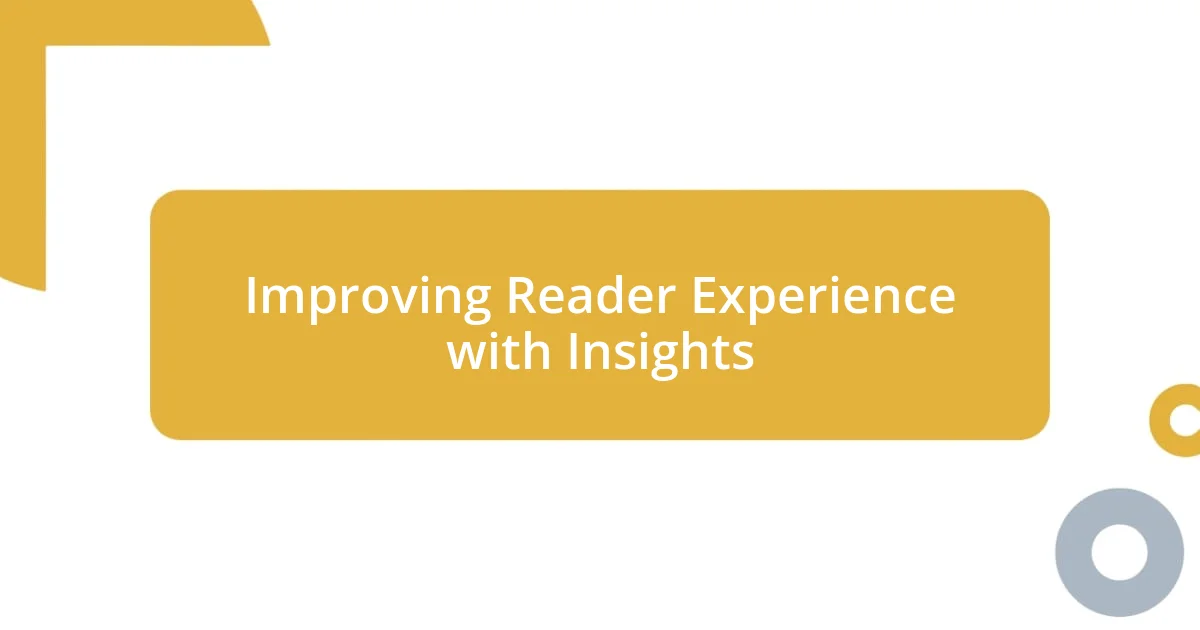Key takeaways:
- Reader analytics enables writers to tailor content to audience preferences, enhancing engagement and fostering a stronger community connection.
- Utilizing tools like Google Analytics and Hotjar provides valuable insights into reader behavior, allowing for data-driven content strategies that improve interaction.
- Incorporating varied content formats, such as multimedia, and understanding reader engagement patterns significantly boosts reader retention and loyalty.

Understanding Reader Analytics Benefits
Reader analytics can be a game changer for anyone looking to enhance their writing. I remember the first time I dove into the data of my readers’ habits; it was eye-opening. I found that certain topics sparked much more interest than I expected, which helped me tailor my future content to better meet my audience’s needs.
One benefit I’ve personally experienced is the ability to identify which pieces resonate the most. Analyzing reader engagement reveals the kind of influences that attract people, making it easier to connect with them emotionally. Have you ever wondered why a particular article of yours took off while another fell flat? Understanding these analytics provides clarity behind those surprises, ensuring you can replicate success moving forward.
Moreover, reader analytics help create a genuine dialogue with your audience. For me, noticing the demographics and reading patterns encouraged a more inclusive approach to my content. It got me thinking: if I can pinpoint who is engaging with my content, wouldn’t it be prudent to engage them directly? By fostering this connection and being responsive to feedback, I found both my confidence and my community grew stronger.

Tools for Effective Reader Analytics
When it comes to effective reader analytics, choosing the right tools is crucial. I’ve experimented with a variety of platforms, and each brought its own unique set of insights. Some tools provide detailed demographic data, while others focus on engagement metrics. It’s fascinating to see how different analytics platforms can highlight various aspects of reader behavior.
Here are some tools I’ve found particularly helpful:
- Google Analytics: Great for tracking website traffic and understanding user interactions.
- Medium Stats: Perfect for gauging article performance directly on the Medium platform.
- Hotjar: Offers heatmaps to visualize where readers engage most on your site.
- BuzzSumo: Helps analyze which content gets the most shares and backlinks, revealing what resonates with your audience.
- Mailchimp Reports: If you’re sending newsletters, their analytics offer insights on open and click rates.
I remember my excitement when I first integrated Hotjar into my workflow. The heatmaps showed me exactly where my readers’ eyes were drawn on my page. It was like having a backstage pass to their habits! This revelation allowed me to restructure my layout, making it far more user-friendly, and ultimately boosting my engagement. These tools not only enrich my understanding but also empower me to craft better content that truly speaks to my audience.

Analyzing Reader Engagement Patterns
Analyzing reader engagement patterns is essential for honing your content strategy. I remember my first attempt at examining reader engagement data; I was surprised to see peaks during certain times of the day. This information allowed me to schedule my posts strategically, maximizing reach and interaction. It’s like having a map to navigate when my audience is most active, which has been a game changer in how I approach content distribution.
As I’ve dug deeper into the analytics, I’ve noticed specific trends emerge based on the type of content I provide. For instance, posts that invite comments or pose questions tend to generate more engagement than purely informative ones. It’s fascinating how a simple shift in tone can encourage a richer dialogue. Have you ever experimented with your writing style to see what resonates? It’s an exhilarating journey to discover the nuances that get readers to interact more deeply with my work.
To make sense of these patterns, here’s a table comparing different aspects of reader engagement analytics tools that I’ve found insightful:
| Tool | Insights Provided |
|---|---|
| Google Analytics | User traffic and behavior analysis |
| Medium Stats | Article performance metrics |
| Hotjar | Heatmaps for visual engagement tracking |
| BuzzSumo | Content share analysis |
| Mailchimp Reports | Email open and click rate statistics |

Leveraging Data for Content Strategy
Leveraging data for content strategy transforms the way I connect with my audience. Recently, I discovered that my posts featuring case studies were attracting more readers than my opinion pieces. This insight inspired me to delve deeper into crafting content that not only informs but also tells compelling stories. Have you ever realized that storytelling can elevate your message? For me, it’s the difference between a casual glance and a captivated reader.
Understanding what types of content perform best is more than just numbers; it’s about connection. I remember looking at the analytics and noticing a spike in engagement when I included personal anecdotes, similar to what I’m sharing now. It’s remarkable how the data revealed my readers craved authenticity and relatability. It made me wonder—what stories can you share to bridge the gap between you and your audience? The right data can guide you to unearth these connections.
When I integrated data into my planning, it felt akin to having a treasure map in a vast ocean. I started scheduling posts based on engagement trends I had identified, and the improvement was palpable. My audience began responding with enthusiasm at the specific times I posted, almost like they were waiting for my content. This experience taught me that leveraging analytics isn’t merely about numbers; it’s about paving the way for meaningful interactions that resonate. Isn’t that what we all strive for in our content journeys?

Improving Reader Experience with Insights
Collecting insights from reader analytics has fundamentally changed how I craft my content. For instance, after analyzing my most successful articles, I found that posts that included multimedia elements—like videos or infographics—captured readers’ attention much more effectively. I remember being thrilled to see comments filled with engagement, and it made me realize: sometimes, a simple visual can convey ideas faster than words alone. Have you considered incorporating more varied formats in your writing?
Another revelation struck me when I began tracking reader behavior beyond the initial click. I noticed how many readers scrolled through my entire article versus those who bounced away after a few sentences. It hit me that keeping readers hooked is an art, and knowing their journey can guide me to create more engaging introductions. What if you could dive into the minds of your readers, understanding exactly what holds their interest? That’s what these insights allow you to do, leading to content that resonates on a deeper level.
By adjusting my content based on these insights, I’ve experienced a notable increase in reader loyalty. Once, a particular blog post sparked an unexpected dialogue in the comments section. Readers were sharing their experiences, creating a community around the topic. Seeing that exchange brought a sense of fulfillment that numbers alone can’t express. Isn’t it rewarding to know your words can spark genuine conversations? It’s moments like these that affirm the value of utilizing reader insights to elevate the overall experience.














